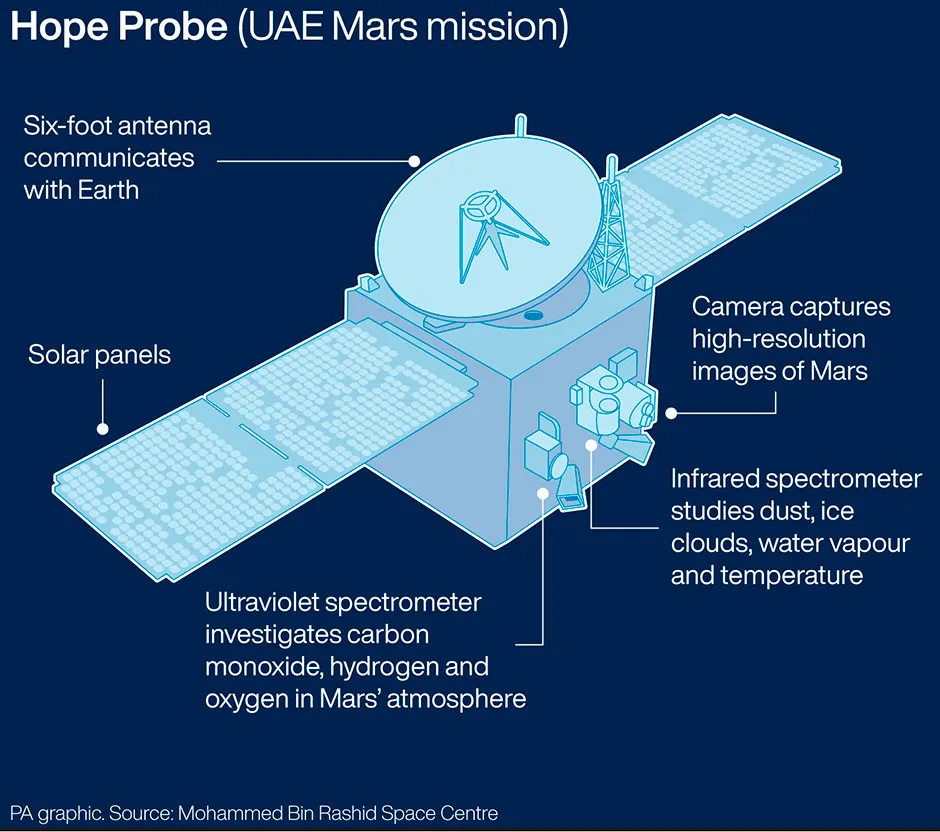The United Arab Emirates’ first Mars mission, using the Hope probe, is expected to enter the Red Planet’s orbit on Tuesday. When the spacecraft arrives, it will make the UAE only the fifth country in history to reach Mars.
The probe will explore the atmosphere of the planet, something that has not been done by any previous Mars mission. Understanding the atmospheres of other planets will allow researchers to better understand Earth, and better understand other planets in the Universe.
Carrying three instruments, Hope will aim to answer questions such as how conditions throughout the Martian atmosphere affect rates of atmospheric escape – specifically how hydrogen and oxygen, building blocks of life, leak from the Martian atmosphere.
The Martian exosphere (upper atmosphere) behaves differently at different times during the day, and at different distances relative to Mars. The instruments will collect different data points on the atmosphere to also gauge seasonal and daily changes.
But entering Mars’s orbit all depends on one critical upcoming moment, Mars Orbital Insertion (MOI).Achieving MOI is a complex manoeuvre, the spacecraft is rotated to position it for a deceleration burn of 27 minutes, and slowed down from its cruising speed of 121,000km/h to something nearer to 18,000km/h.The burn will start at around 3:30pm GMT.
Read more about Mars:
- Ancient megaflood hints at possibility of life on Mars
- Glaciers on Mars reveal the Red Planet went through multiple ice ages
The stresses on the spacecraft of all engines firing at once are far beyond those at launch and it will be completed with a 22-minute two-way radio delay from Earth, requiring the probe to be highly autonomous.
Around 10 minutes after the MOI burn, the Hope probe flies into the dark side of Mars.
After the gravity of Mars captures Hope, it will enter a phase called the capture orbit. The capture orbit takes the spacecraft from a distance of 1,000 to 49,380 km from Mars’s planetary surface.
In this phase, instrumentation will be tested and the spacecraft will, over the coming two months, transition to its science orbit.The transition to Hope’s science orbit will be completed by April 2021.
The probe has a 20,000–43,000 km elliptical science orbit, and completes one orbit of the planet every 55 hours.
While it will be in daily contact with Earth during the capture orbit phase, in its science orbit, contacts will take place two to three times a week with each pass being some six to eight hours in order to download data and upload updates and instructions.

Sarah bint Yousef Al Amiri, minister of state for advanced technologies, chair of the UAE Space Agency, said she hopes the mission will be in a position to share data by September.
“One of our primary objectives is to ensure that we share the data as soon as we are comfortable, as a science team, that the data is usable by scientists and the data is correct," she told the PA news agency.
“So we’ve put about three months of time to ensure that our processing is correct, that the instrument is behaving appropriately, that the output that we’re getting is actually from Mars observations and not Mars observations with something on the instrument or something in the processing.
“We hope to release the data at the latest in the beginning of September, and it will be data from the capture orbit that has been captured around Mars, and also from the beginning of our science phase.”
She added: “A lot of what we’re hoping to discover from the data of this mission is new, and this is a highly complimentary mission to other missions so we truly hope that others’ missions around Mars will utilise also our data in conjunction with their data.
“And there’s actually talks with a few teams, who have spacecrafts around Mars, to see how we can further collaborate and expand all of our science so analysis capabilities utilising more and more data.”
The Hope mission is one of three Mars landings to take place this month. The others are NASA’s Perseverance rover and China’s Tianwen-1 mission.
Reader Q&A: How did Mars lose its atmosphere?
Asked by: Aseer Awsaf
Mars today has a thin atmosphere: the volume of gases (mostly carbon dioxide) in its atmosphere is less than 1 per cent that of Earth’s. However, evidence from the surface of Mars indicates that the planet was once much warmer and wetter than today. This suggests that the Martian atmosphere must once have been much thicker, creating a strong greenhouse effect that trapped the Sun’s light.
Thanks to numerous missions to the Red Planet, we now know that in its early infancy, up until around four billion years ago, Mars had a strong magnetic field, created, just like Earth’s, by convection currents of molten metals in the planet’s core. But, unlike Earth, Mars cooled enough internally to switch off this mechanism, and the planet ended up with no global magnetic field. Without this magnetic field, the planet was less protected from the solar wind – the stream of energetic charged particles flowing from the Sun.
The solar wind stripped away most of the Martian atmosphere in only a few hundred million years after the planet lost its magnetic field. This process was quick because the Sun rotated much faster in its youth, which made the solar wind more energetic. The loss of a large fraction of its atmosphere to space was a major cause of Mars’s transition from a warm, wet climate to today’s cold, dry one.
In contrast, the fact that the Earth retained its magnetic field, which deflects the solar wind, and hence held on to its atmosphere, ultimately allowed life to develop here.
Read more: